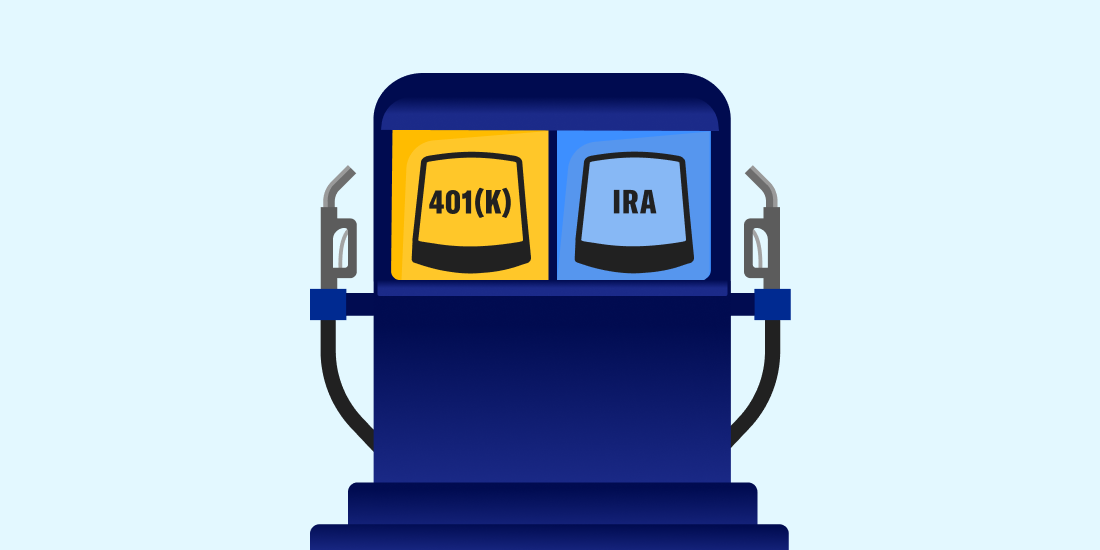
Can you have both a 401(k) and an IRA? Yes! But having access to both accounts begs the question:
Which one is more deserving of your retirement dollars?
The answer, as it so often does in personal finance, depends on your situation. So let’s explore when a 401(k)-first mentality makes sense, and when it doesn’t, before closing things out with a wildcard third option that might warrant both your attention and your savings.
A quick refresher on retirement accounts
For the sake of this conversation, we’re focusing on the two most common retirement accounts: the IRA and the 401(k), including the non-profit/public equivalent 403(b) account. Both come with built-in tax advantages, annual contribution limits, and eligibility criteria:
401(k)
- Accessible to: Anyone whose employer offers one
- 2024 contribution limit: $23,000 (for those under 50)
IRA
- Accessible to: Anyone whose Modified Adjusted Gross Income (MAGI) falls below the IRS’s eligibility limits (see table below) qualifies for tax benefits.
- 2024 contribution limit: $7,000 (for those under 50)
2024 IRA income limits
| Traditional IRA* | Modified Adjusted Gross Income (MAGI) | Roth IRA | Modified Adjusted Gross Income (MAGI) |
|---|---|---|---|
| Full tax deduction | $0-$77,000 (single) |
Full contribution |
$0-$145,999 (single) |
| $0-$123,000 (married) |
$0-$229,999 (married) |
||
| Partial tax deduction |
$77,001-$86,999 (single) |
Partial contribution |
$146,000-$160,999 (single) |
|
$123,001-$142,999 (married) |
$230,000-$239,999 (married) |
||
| No tax deduction** |
$87,000 and up (single) |
No contribution |
$161,000 and up (single) |
|
$143,000 and up (married) |
$240,000 and up (married) |
*If covered by a retirement plan at work
**Anyone is eligible to make taxable contributions to a traditional IRA
Source: IRS
Power ranking your retirement accounts
In general, there are a few reasons why you might default to the 401(k), including but not limited to:
- You can contribute by way of payroll deductions and ease the sting of saving.
- Many employers offer matching contributions, aka free money.
- And you can contribute significantly more money to them than IRAs.
Altogether, that’s a lot of pros working in the 401(k)’s favor.
But not all 401(k)s are created equal. Some providers charge more for limited investment options. According to the 24th edition of the 401k Averages Book, the average investment expense for some smaller plans1 was 1.12%.
By comparison, you can invest with a Betterment IRA for an all-in fee well south of 1%—and receive a 1% matching contribution to boot.
So ask your employer or 401(k) provider for help sizing up your total costs. Or take a look at your 401(k) statement for code names like:
- Management fees
- Asset-based fees
- Operating expenses
- Expense ratios
If you find your 401(k) costs are significantly steeper than an IRA, consider the following order of operations:
- Fill up your 401(k) up to your employer’s match, assuming they offer one.
- Max out your IRA, assuming you’re eligible.
- Come back to your 401(k).
On the other hand, if your 401(k)’s fees are competitive, congratulations! Things just got simpler. Consider maxing it out first before turning your attention to an IRA, or that wildcard option we mentioned earlier.
A quick aside on the Health Savings Account (HSA)
Sure, the name says “health,” but HSAs can be repurposed for retirement savings as well. They come with a $4,150 contribution limit for individuals, and they’re available to anyone enrolled in a high-deductible health plan (HDHP).
They’re also triple tax-advantaged, meaning money is tax-free going in, tax-free while it grows, and tax-free coming out, assuming it’s used for qualified expenses. That’s one more tax perk than 401(k)s and IRAs, which make you choose between either tax-deferred contributions or tax-free withdrawals.
|
Tax-free contributions |
Tax-free |
Tax-free withdrawals |
|
|
Traditional 401(k)/IRA |
✓ |
✓ |
X |
|
Roth 401(k)/IRA |
X |
✓ |
✓ |
|
HSA |
✓ |
✓ |
✓ |
So if an HDHP is right for your healthcare needs, consider prioritizing an HSA before an IRA. Between those two accounts and the 401(k), that’s more than $30,000 worth of annual investing potential. Fill up those tanks, and you’ll be well on your way to retiring. Now just enjoy the ride.









